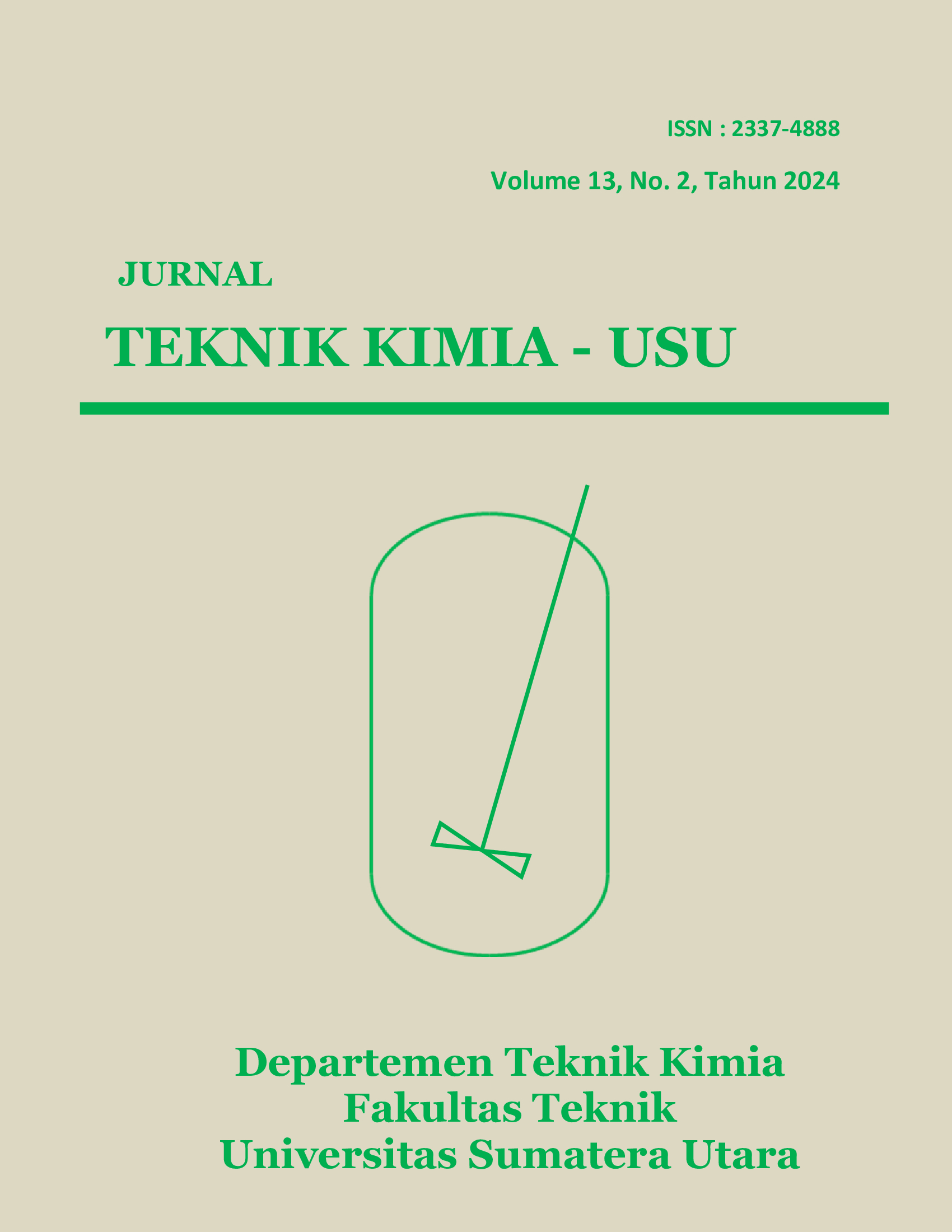Pengurangan Nilai COD pada Effluent Fermentor Biogas UASB-HCPB dengan Memanfaatkan Mikroalga Chlorella vulgaris
DOI:
https://doi.org/10.32734/jtk.v13i2.16161Keywords:
chorella vulgaris, COD, UASB-HCPB fermentor effluentAbstract
Palm oil mill effluent (POME) is the main waste generated from the palm oil industry. LCPKS has a COD level of 57,000-60,400 mg/L. High levels of COD can harm the environment. LCPKS treatment techniques generally use a combination of anaerobic and aerobic waste treatment methods. The anaerobic process has been conducted using a UASB-HCPB reactor. But, the COD levels of anaerobic results have not reached the quality standards so that further processing is needed. Microalgae have the potential to reduce contaminant levels in wastewater. Chlorella vulgaris microalgae is a microalgae that is widely used in wastewater treatment. This study utilized Chorella vulgaris in reducing the COD levels of the effluent of the UASB-HCPB biogas fermentor with variations in lighting intensity and variations in the ratio of effluent to microalgae. It was found that the lighting intensity of light:dark (24:0) hours provided optimal microalgae growth so as to provide the best COD reduction with a COD reduction efficiency of 87.5%. The ratio of microalgae to effluent of 1000 mL: 500 mL showed the best COD reduction with an efficiency of 93.75%.
Downloads
References
W. S. Winanti, Prasetiyadi, Wiharja, “Pengolahan palm oil mill effluent (pome) menjadi biogas dengan sistem anaerobik tipe fixed bed tanpa proses netralisasi,†Jurnal Teknologi Lingkungan, vol. 20, no.1, pp. 143-150, 2019.
D. P. Yuniarti, R. Komala, dan S. Aziz, D, “Pengaruh proses aerasi terhadap pengolahan limbah cair pabrik kelapa sawit di PTPN VII secara aerobik,â€Jurnal Teknik Lingkungan, vol. 4, no. 2, pp. 7-16, 2019.
A. A. Zinatizadeh, P. Mohammadi, M. Mirghorayshi, S. Ibrahim, H. Younesi, and A. R. Mohamed, “An anaerobic hybrid bioreactor of granular and immobilized biomass for anaerobic digestion (AD) and dark fermentation (DF) of palm oil mill effluent: mass transfer evaluation in granular sludge and role of internal packing,†Biomass Bioenergy, vol. 103, pp. 1-10, 2017.
D. S. Sembiring, B. Trisakti, and D. N. S. Sihombing, “Stabilitas reaktor uplow anaerobic sludge blanket-hollow centered packed bed dalam produksi biogas pada kondisi ruangan,†Jurnal Teknik Kimia USU, vol. 8, no. 2, pp. 67–71, 2019.
M. Rajanandini, and S. N. Kumar, “A biological and technological approach to treat wastewater by using macroalgae and microalgae photo bio and photo catalytic reactors view project bioreactors for crepe cotton wastewater treatment view project a biological and technological approach to treat wastewater by using macroalgae and microalgae,†Research Journal of Chemistry and Environment, vol. 25, no. 6, pp. 181-187, 2021.
S. Elystia, F. A. Hasti, and S. R. Muria, “Pengolahan limbah minyak sawit menggunakan Chlorella sp. yang diimobilisasi dalam flat-fotobioreaktor,†Jurnal Sains dan Teknologi, vol. 11, no. 1, pp. 67–76, 2022.
S. R. Muria, Chairul, dan D. C. Naomi, “Pemanfaatan mikroalga Chlorella sp. untuk pengolahan palm oil mill effluent (POME) secara fed batch,†Jurnal Sains dan Teknologi, vol. 19, no. 1, pp. 7–12, 2020.
Z. Selvika, A. B. Kusuma, N. E. Herliany, and B. F. S. P. Negara, “Pertumbuhan Chlorella sp. Pada Beberapa Konsentrasi Limbah Batubara,†Depik, vol. 5, no. 3, pp. 107-112, 2016.
K. D. Dewi, P. Santoso, and N. Dahoklory, â€Karakteristik pertumbuhan Chaetoceros sp berdasarkan intensitas cahaya yang berbeda,†Jurnal Vokasi Ilmu-Ilmu Perikanan, vol. 3, no. 2, pp. 96-100, 2023.
R. Ramaraj, Y. Unpaprom, and N. Dussadee, “Cultivation of green microalga, Chlorella vulgaris for biogas purification,†International Journal of New Technology and Research, vol. 2, no. 3, pp. 117-122, 2016.
Y. Arkeman, L. Haris, G. Saefurahman, I. Hermadi, and D. S. Wibawa, “Cellular automata machine modeling to obtain optimal conditions and productivity of microalgae biomass. in IOP Conference Series: Earth and Environmental Science, Institute of Physics, 2021.
L. D. Prasetyo, E. Supriyantini, and S. Sedjati, “Pertumbuhan mikroalga Chaetoceros calcitrans pada kultivasi dengan intensitas cahaya berbeda,†Buletin Oseanografi Marina, vol. 11, no. 1, pp. 59–70, 2022.
H. S. Yun, Y. S. Kim, and H. S. Yoon, “Characterization of Chlorella sorokiniana and Chlorella vulgaris fatty acid components under a wide range of light intensity and growth temperature for their use as biological resources,†Heliyon, vol. 6, no. 7, pp. 1-9, 2020.
M. A. Yaakob, R. M. S. R. Mohamed, A. Al-Gheethi, G. A. Ravishankar, and R. R. Ambati, â€Influence of nitrogen and phosphorus on microalgal growth, biomass, lipid, and fatty acid production: an overview,†Cells, vol. 10, no. 393, 2021.
M. Fathurohman, H. Herdiana, W. T. Wulandari, A. Tri, and K. Pratita, â€Uji aktivitas antioksidan senyawa eksopolisakarida dari mikroalga Chlorella pyrenoidosa dengan metode DPPH (2,2-diphenyl-1-picrylhidrazyl),†Prosiding Seminar Nasional Diseminasi Penelitian, vol. 3, pp. 112-123, 2023.
L. Neneng, Nawan, dan A. Adelia, “Pengaruh tahapan bioremediasi terhadap efektivitas eliminasi merkuri (Hg) di media cair,†Jurnal Ilmiah Kanderang Tingang, vol. 14, no. 1, pp. 70–79, 2023.
M. Chairani, S. Elystia, dan S. R. Muria, “Penyisihan nitrogen total dalam limbah cair hotel dengan sistem moving bed biofilm reactor menggunakan Chlorella sp,†Jurnal Sains dan Teknologi, vol. 10, no. 1, pp. 16-27, 2021.
S. R. Muria, F. M. Shiddiq, I. Damayanti, and I. Purnama, “Kultivasi mikroalga Chlorella sp. secara fed-batch menggunakan limbah cair tahu untuk produksi lipid,†JBChEES, vol. 4, no. 1, pp. 37-56, 2023.
Widayat and Hadiyanto, “Pemanfaatan limbah cair industri tahu untuk produksi biomassa mikroalga Nannochloropsis Sp sebagai bahan baku biodiesel,†Reaktor, vol. 15, no. 4, pp. 253-260, 2015.
I. Mishbach, N. S. Permatasari, M. Zainuri, H. P. Kusumaningrum, and E. D. Hastuti, “potensi mikroalga Anabaena sp. sebagai bahan utama bioetanol,†EKOTONIA: Jurnal Penelitian Biologi, Botani, Zoologi dan Mikrobiologi, vol. 7, no. 1, pp. 69–76, 2022.
Q. Emparan, R. Harun, and J. A. Kodiappan,†effect of microalgae-to-palm oil mill effluent (POME) ratio for rapid effective pollutants removal and biomass production,†Desalination Water Treat, vol. 198, pp. 119–125, 2020.
Downloads
Published
Issue
Section
License
Copyright (c) 2024 Jurnal Teknik Kimia USU

This work is licensed under a Creative Commons Attribution-ShareAlike 4.0 International License.

















